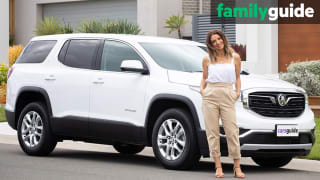
Holden Acadia LT 2019 review
The Acadia offers an American made alternative to cars like the Mazda CX-9, Toyota Kluger and Kia Sorento. How does it compare to these cars?
Browse over 9,000 car reviews
If the Nissan Pathfinder was a person, it would probably be tired of explaining to everybody it met that, "Sorry, no, I'm not the Nissan X-Trail."
Nope, the X-Trail is the Pathfinder’s similar looking but smaller and super popular sibling. To add to that case of mistaken identity the X-Trail also comes with seven seats.

So, what the difference between these two Nissans that seem so much alike? And how does the Pathfinder compare with rivals such as the Holden Acadia?
Read on to find out… oh and be sure to check out our comparison video above.
| Nissan Pathfinder 2020: ST+ (4WD) | |
|---|---|
| Safety rating | |
| Engine Type | 3.5L |
| Fuel Type | Premium Unleaded Petrol |
| Fuel Efficiency | 10.1L/100km |
| Seating | 7 seats |
| Price from | $38,940 |
First up, the Pathfinder is a large SUV and would count the Holden Acadia, Mazda CX-9 and Kia Sorento as its rivals, while the X-Trail is a mid-sized SUV and goes up against the Mazda CX-5, Kia Sportage and Toyota RAV4.
The Pathfinder probably looks as familiar to you as your front door and chances are this large SUV has been around longer then you’ve been living in your home. See, this fourth-generation large SUV first arrived in 2013.

Yup, 2013. Life was looking up. There was President Barak Obama, the iPhone 5, the Minions movie, and the Nissan Pathfinder. Good times.
So, while this is the most up-to-date version of the Pathfinder this is still the same generation car that arrived in 2013 and despite revisions over the years it has retained its original look.
Not that there’s anything wrong with it – the exterior styling has held up well with its rough and handsome looks.
There’s not much separating an ST+ from the other grades in the line-up, visually. As you step up through the more expensive levels, you’ll see fog lights and a sunroof come in with the ST-L and larger wheels on the Ti, but for the most part you’re not missing out on better styling by choosing the ST+.
The Pathfinder’s cabin hasn’t aged as well as its exterior with its dashboard sporting a myriad of buttons and a dated looking instrument cluster.
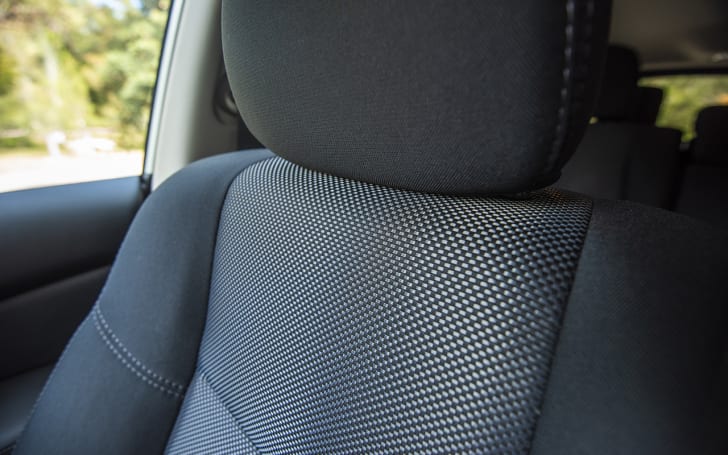
Cloth seats, while comfortable, aren’t as stylish as ones I’ve seen on more recent SUVs such as Holden’s Acadia, either.
Will the Pathfinder fit in your garage? Well, the dimensions are: 5042mm long, 1963mm wide and 1793mm tall.
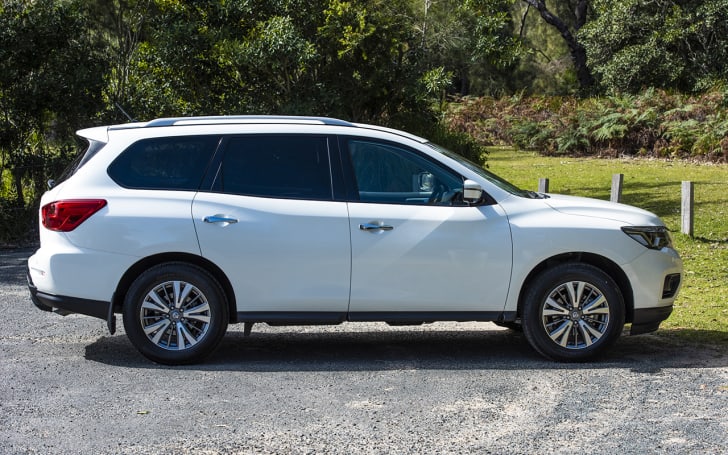
An X-Trail is a lot smaller – it’s 4.7m end-to-end and 1.8m across.
The Pathfinder ST+ with all-wheel drive (AWD) lists for $48,090, which is $3500 more than the front-wheel drive version. FYI, the ST+ costs $2200 more than the ST.
What’s the difference between the entry grade ST and an ST+? Sat nav and a 360-degree camera with moving object detection, is all. Is it worth the money? Nope, not in my books.
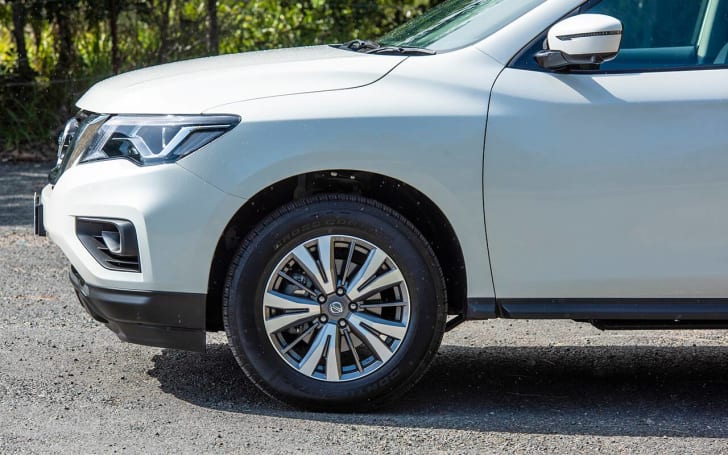
Well, okay, the camera and movement detection is good, especially if you have children. Sat nav is not necessary if you get a holder for your phone and use its maps app. Apply CarPlay or Android Auto? Not on the Pathfinder.
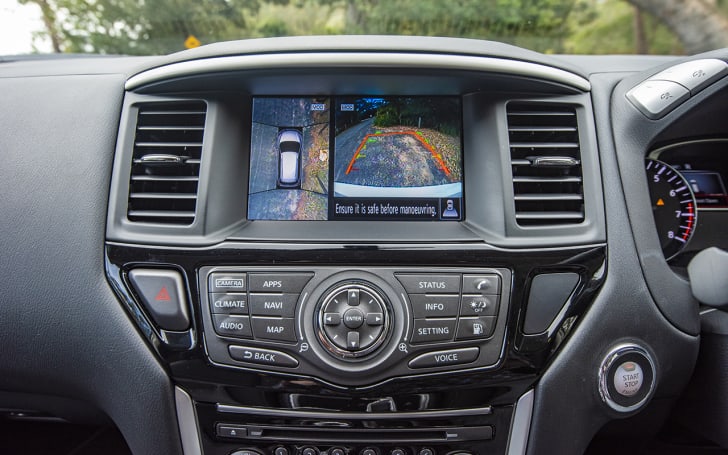
Apart from the sat nav and surround view camera, the ST+ has an identical features list. Included are 18-inch alloy wheels, roof rails, LED running lights, three-zone climate control, power driver’s seat, proximity key, rear parking sensors, Bluetooth connectivity, a six-speaker stereo, privacy glass and floor mats.
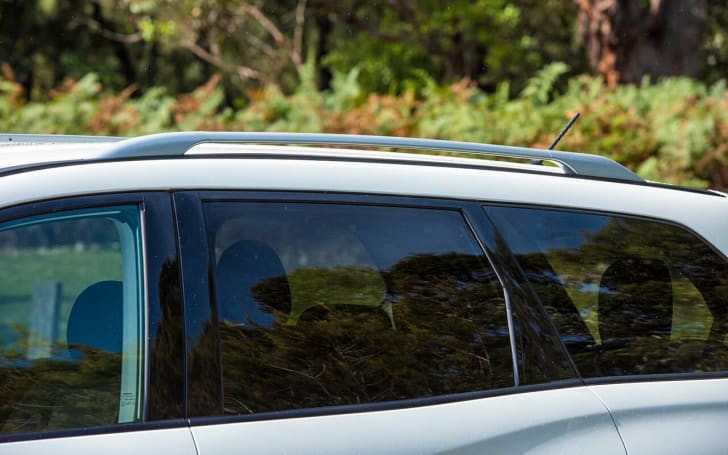
For nearly $10K less you could get a seven-seat X-Trail. Just saying – but you don’t get AWD, or the enormous boot of the Pathfinder.
The Pathfinder ST+ is a spacious seven-seater SUV with an impressive cargo capacity.
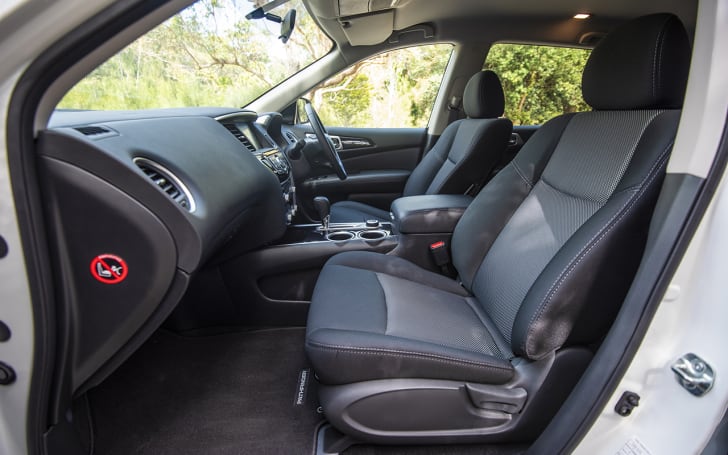
Space up front is excellent, with good head, shoulder and elbow room even for somebody with my 2.0m wingspan and 191cm height. Also, I can sit behind my driving position and behind that in the third row without my knees touching any of the seat backs.
Directional air vents in all three rows, plus large windows make life more comfortable for everybody. So does the raised second row which offers a view over the top of the driver and co-pilot.
The floor does seem overly elevated in the Pathfinder which places the knees of second and third row passengers higher. For a model comparison see the Pathfinder ST+ vs Holden Acadia LT video above.
Boot space with the third-row seats up is 453 litres opening up to 1354 litres with them folded flat and the second row in place. You’ll find extra storage space under the boot floor.
Just as a model comparison the X-Trail has 445 litres of boot space with the third row folded.
Cabin storage is excellent with 10 cupholders (yes, 10) on board (two up front, four in the second row and another four in the back row); large door pockets, a tray in front of the shifter and a deep centre console storage bin.
For charging and media there are three 12-volt and two USB outlets up front and two USB charging points and a media USB port in the second row.
Room for improvement? Well, the Pathfinder could do with wireless charging and it’s also lacking USB ports in the third row.
You can have your Pathfinder with a petrol engine or with hybrid system.
My ST+ had the 3.5-litre V6 petrol with the continuously variable transmission (CVT). The V6 makes plenty of grunt with 202kW of power and 340Nm of torque although acceleration feels a little lackluster mainly due to the nature of the CVT auto.
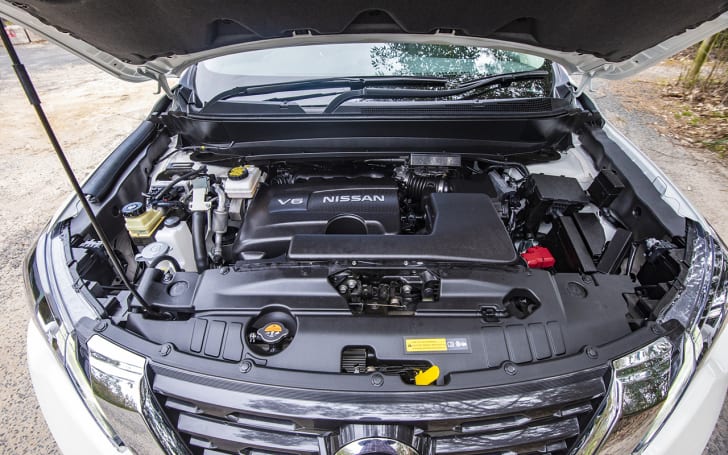
The ST+ tested was an AWD with a selector allowing the driver to switch to front-wheel drive or an auto setting which maintains optimum traction for all four wheels.
The lack of a stop-start fuel saving system or cylinder deactivation can make the V6 thirsty in the city as you’ll see below.
The official fuel consumption claim for the V6 petrol-powered Pathfinder is 10.1L/100km over a combination of open and urban roads.
Testing over 134km of city and rural roads saw the Pathfinder ST+ with AWD use 14.9L/100km measured at the fuel pump.
Keep in mind that this was after hilly country roads followed by afternoon peak-hour city traffic. Having tested Pathfinders before I know motorway usage lowers this figure substantially.
That said, the AWD Pathfinder is heavy at 2005kg and doesn’t come with fuel-saving tech like cylinder deactivation or a stop-start system
The Pathfinder was given a five-star ANCAP rating when it was tested in 2013, but a major safety update in 2019 brought much-needed advanced technology to the entry grade ST, also included on the ST+.
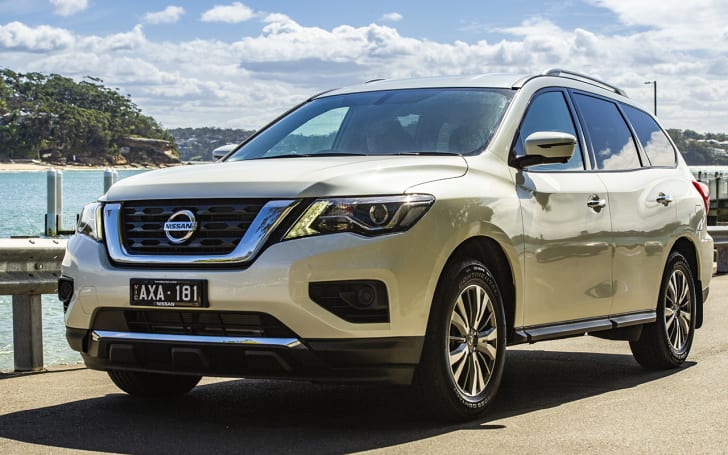
Standard safety equipment on the ST+ includes AEB with forward collision warning, blind spot monitoring, rear cross traffic alert, adaptive cruise control and air bags which extend to cover the third row.
For child seats you’ll find two ISOFIX mounts and three top tether points in the second row and a third top tether point in the right-hand-side seat in the third row.
The Pathfinder is made in the United States, in Tennessee to be exact, and this is why when you go to fold the second row seats it’s the larger section which is on the left side of the car, and that’s frustrating for Aussies trying to get into the rear seats on the traffic-side of the car.
A space-saver spare wheel is under the car.
Basic Warranty
5 years / unlimited km warranty
ANCAP Safety Rating

The Pathfinder ST+ is covered by Nissan’s five year/unlimited km warranty.
Servicing is recommended every 10,000km or 12 months. As a guide you can expect to pay $290 for the first service, $309 for the next, $458 for the third, $367 for the fourth, $314 for the fifth and $502 for the sixth.
Comfortable and easy are two words which come to mind when describing what the Pathfinder ST+ is like to drive. That’s thanks to large comfortable seats, light steering, great visibility through those large windows and plenty of grunt.
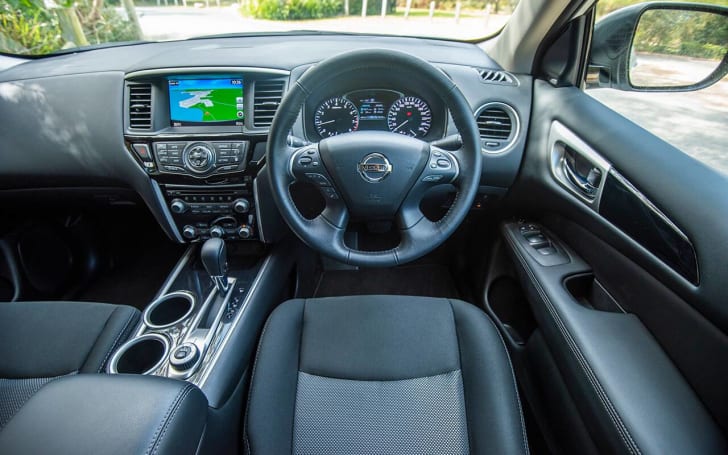
It’s not perfect though, and if you watch the video above, I compared the Holden Acadia to the Pathfinder and found the Nissan’s ride is not as composed as its rival.
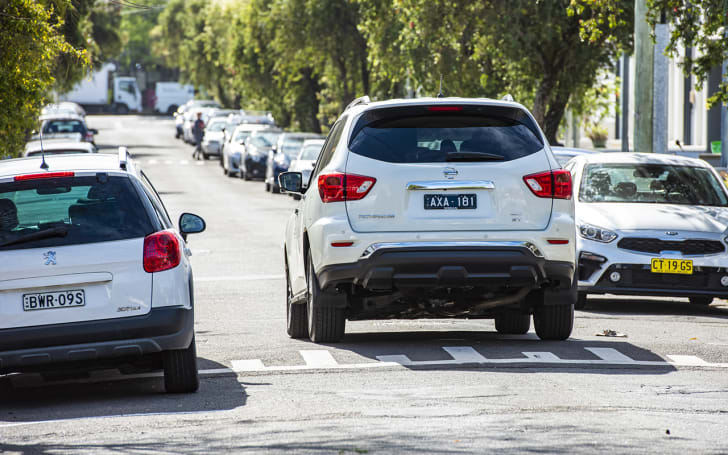
That said, neither of these SUVs are dynamic and suit cruising through the burbs or on the motorway rather than on challenging winding roads.
If you are planning to tow with the Pathfinder it could be the best of its rivals for the job with its 2700kg braked towing capacity (the Acadia can only manage 2000kg).
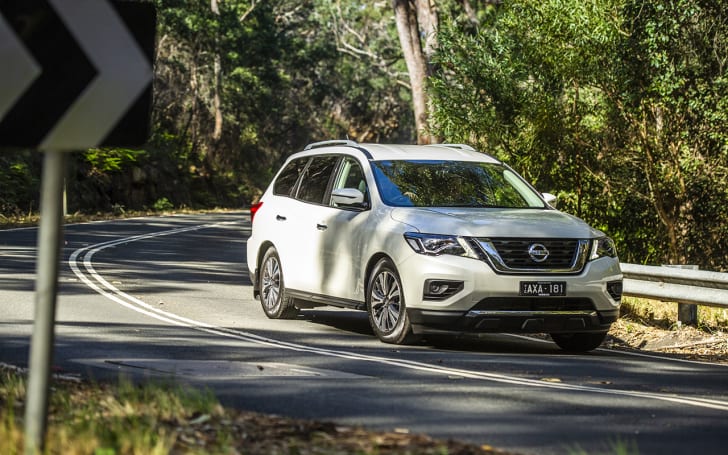
A 180mm ground clearance is low for an SUV but it’ll get down bumpy dirt roads that a regular hatch or sedan would get beached on.
If you’re buying an entry-grade Nissan Pathfinder now, you’re in luck – the 2019 safety upgrade brought in the tech that was needed and the ST+ adds good convenience features such as the sat nav and surround view camera with moving object detection.
Yes, this generation of Pathfinder has been around forever in car terms, but the revisions have kept it from falling too far behind.
There are some areas that could be improved – Apple CarPlay and Android Auto should be standard, and the ride could be more composed for a more comfortable experience.
| Vehicle | Specs | Price* | |
|---|---|---|---|
| ST Hybrid (2WD) | 2.5L, Hyb/PULP, CVT AUTO | $31,570 – 38,060 | 2020 Nissan Pathfinder 2020 ST Hybrid (2WD) Pricing and Specs |
| ST (2WD) | 3.5L, PULP, CVT AUTO | $34,870 – 41,470 | 2020 Nissan Pathfinder 2020 ST (2WD) Pricing and Specs |
| ST+ (2WD) | 3.5L, PULP, CVT AUTO | $35,640 – 42,460 | 2020 Nissan Pathfinder 2020 ST+ (2WD) Pricing and Specs |
| ST (4WD) | 3.5L, PULP, CVT AUTO | $38,060 – 44,770 | 2020 Nissan Pathfinder 2020 ST (4WD) Pricing and Specs |
| Design | 7 |
|---|---|
| Price and features | 7 |
| Practicality | 8 |
| Under the bonnet | 6 |
| Efficiency | 6 |
| Safety | 8 |
| Ownership | 8 |
| Driving | 7 |
$22,990
Lowest price, based on 18 car listings in the last 6 months